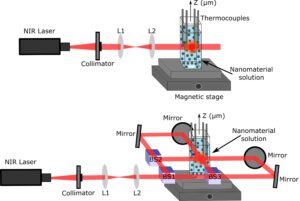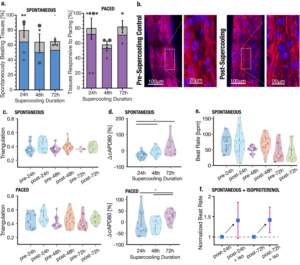TiN-Au plasmonic NPs and beam splitting for rapid warming
 The project’s research aims to improve the efficiency and uniformity of photothermal warming using TiN nanoparticles and clusters. Titanium Nitride (TiN) nanoparticles, which offer significant advantages over gold nanoparticles. They have higher heating rates, better optical properties for absorption and scattering, are more cost-effective, and possess greater thermal stability.
The project’s research aims to improve the efficiency and uniformity of photothermal warming using TiN nanoparticles and clusters. Titanium Nitride (TiN) nanoparticles, which offer significant advantages over gold nanoparticles. They have higher heating rates, better optical properties for absorption and scattering, are more cost-effective, and possess greater thermal stability.
This is implemented using beam splitting setup, dividing the laser beam into four beams. Furthermore, we’ve collaborated with the Yadong Yin lab at UCR to develop

TiN clusters. These clusters increase the scattering cross-section, leading to a better absorption and scattering ratio, which promotes more even warming.
 Isochoric supercooled preservation and revival of human cardiac microtissues
Isochoric supercooled preservation and revival of human cardiac microtissues
This projects sets out to explore two approaches for making transplantable biologics available on demand: low-temperature biopreservation and 3D tissue engineering.
The goal is to achieve stable and predictable supercooling by using isochoric supercooling to preserve a functional 3D cardiac microphysiological system (MPS) for days without non-physiological cryoprotectants. This MPS serves as a valuable testbed for organ preservation in a human context. Isochoric supercooling offers a simple, ice-free preservation method at sub-0 °C, applicable to various biologics in high-subzero temperatures.
This engineered tissue offers a valuable platform for studying organ preservation within a genetically human context, providing a high-content, low-risk testbed.
